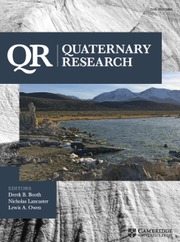Crossref Citations
This article has been cited by the following publications. This list is generated based on data provided by
Crossref.
Rea, David K.
and
Leinen, Margaret
1988.
Asian aridity and the zonal westerlies: Late Pleistocene and Holocene record of eolian deposition in the northwest Pacific Ocean.
Palaeogeography, Palaeoclimatology, Palaeoecology,
Vol. 66,
Issue. 1-2,
p.
1.
Diaz, Henry F.
Andrews, John T.
and
Short, Susan K.
1989.
Climate Variations in Northern North America (6000 BP to Present) Reconstructed from Pollen and Tree-Ring Data.
Arctic and Alpine Research,
Vol. 21,
Issue. 1,
p.
45.
Frenzel, Burkhard
1991.
Progress in Botany.
p.
359.
Sumin, Wang
Yunfei, Wang
Ruijin, Wu
and
Jianren, Li
1991.
Qinghai lake fluctuation and climatic change singce the last glaciation.
Chinese Journal of Oceanology and Limnology,
Vol. 9,
Issue. 2,
p.
170.
Gasse, F.
Arnold, M.
Fontes, J. C.
Fort, M.
Gibert, E.
Huc, A.
Bingyan, Li
Yuanfang, Li
Qing, Liu
Mélières, F.
Campo, E. Van
Fubao, Wang
and
Qingsong, Zhang
1991.
A 13,000-year climate record from western Tibet.
Nature,
Vol. 353,
Issue. 6346,
p.
742.
Peimin, Pu
Qingying, Tu
and
Sumin, Wang
1991.
Progress of limnology in China.
Chinese Journal of Oceanology and Limnology,
Vol. 9,
Issue. 3,
p.
193.
Kashiwaya, Kenji
Yaskawa, Katsumi
Yuan, Baoin
Liu, Jiaqi
Gu, Zhaoyan
Cong, Shaoguang
and
Masuzawa, Toshiyuki
1991.
Paleohydrological processes in Siling‐CO (lake) in the Qing‐Zang (Tibetan) Plateau based on the physical properties of its bottom sediments.
Geophysical Research Letters,
Vol. 18,
Issue. 9,
p.
1779.
Lees, Brian G.
1992.
Geomorphological evidence for late Holocene climatic change in northern Australia.
Australian Geographer,
Vol. 23,
Issue. 1,
p.
1.
Van Campo, Elise
and
Gasse, Francoise
1993.
Pollen- and Diatom-Inferred Climatic and Hydrological Changes in Sumxi Co Basin (Western Tibet) since 13,000 yr B.P..
Quaternary Research,
Vol. 39,
Issue. 3,
p.
300.
Morinaga, H.
Itota, C.
Isezaki, N.
Goto, H.
Yaskawa, K.
Kusakabe, M.
Liu, J.
Gu, Z.
Yuan, B.
and
Cong, S.
1993.
Oxygen‐18 and carbon‐13 records for the last 14,000 years from Lacustrine carbonates of Siling‐Co (Lake) in the Qinghai‐Tibetan Plateau.
Geophysical Research Letters,
Vol. 20,
Issue. 24,
p.
2909.
Kashiwaya, Kenji
Masuzawa, Toshiyuki
Morinaga, Hayao
Yaskawa, Katsumi
Baoyin, Yuan
Jiaqi, Liu
and
Zhaoyan, Gu
1995.
Changes in hydrological conditions in the central Qing-Zang (Tibetan) Plateau inferred from lake bottom sediments.
Earth and Planetary Science Letters,
Vol. 135,
Issue. 1-4,
p.
31.
BORNBUSCH, ALAN H.
1995.
Phylogenetic relationships within the Eurasian catfish family Siluridae (Pisces: Siluriformes), with comments on generic validities and biogeography.
Zoological Journal of the Linnean Society,
Vol. 115,
Issue. 1,
p.
1.
Savoskul, O.S.
and
Solomina, O.N.
1996.
Late-Holocene glacier variations in the frontal and inner ranges of the Tian Shan, central Asia.
The Holocene,
Vol. 6,
Issue. 1,
p.
25.
Lehmkuhl, Frank
1997.
Late pleistocene, Late-glacial and Holocene glacier advances on the Tibetan Plateau.
Quaternary International,
Vol. 38-39,
Issue. ,
p.
77.
Frenzel, Burkhard
1998.
Progress in Botany.
Vol. 59,
Issue. ,
p.
599.
Denniston, Rhawn F.
González, Luis A.
Asmerom, Yemane
Sharma, Ram H.
and
Reagan, Mark K.
2000.
Speleothem Evidence for Changes in Indian Summer Monsoon Precipitation over the Last ∼2300 Years.
Quaternary Research,
Vol. 53,
Issue. 2,
p.
196.
Lehmkuhl, Frank
and
Haselein, Frank
2000.
Quaternary paleoenvironmental change on the Tibetan Plateau and adjacent areas (Western China and Western Mongolia).
Quaternary International,
Vol. 65-66,
Issue. ,
p.
121.
Lehmkuhl, F
Klinge, M
Rees-Jones, J
and
Rhodes, E.J
2000.
Late Quaternary aeolian sedimentation in central and south-eastern Tibet.
Quaternary International,
Vol. 68-71,
Issue. ,
p.
117.
Jia, Yulian
Shi, Yafeng
Wang, Sumin
Jiang, Xuezhong
Li, Shijie
Wang, Aijun
and
Li, Xusheng
2001.
Lake-expanding events in the Tibetan Plateau since 40 kaBP.
Science in China Series D: Earth Sciences,
Vol. 44,
Issue. S1,
p.
301.
Shi, Qi
Chen, Fa-Hu
Zhu, Yan
and
Madsen, David
2002.
Lake evolution of the terminal area of Shiyang River drainage in arid China since the last glaciation.
Quaternary International,
Vol. 93-94,
Issue. ,
p.
31.

